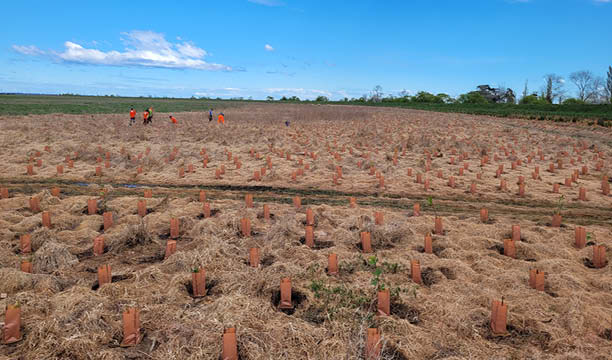- Track your orders
- Save your details for express checkout
- Join our loyalty points scheme and receive points and future discounts with every purchase
|
Spring is in the air, and with it comes new life and hope for Lake Ellesmere, also known as Te Waihora, near Christchurch, Canterbury. This stunning lake, once neglected and overrun by non-native grasses, is undergoing a massive transformation thanks to an ambitious mass planting project. The goal is simple yet profound: to bring Lake Ellesmere back to life by restoring its native trees and wildlife. This restoration effort represents a joint commitment from the conservation department, local landowners, community groups, and Iwi, illustrating how collective action can breathe new life into a cherished ecosystem. |
| Currently, a massive planting initiative is in progress along the long-neglected shoreline of a Canterbury lake. The project's primary objective is to rejuvenate the area by reintroducing native trees and wildlife, which have been absent for far too long. The landscape has been dominated by non-native grasses and paddocks, making this endeavor a vital step toward restoring the region's ecological balance. The Department of Conservation (DOC) has taken a significant step in its commitment to environmental sustainability by partnering with Advance Landscape Systems to use their Combiguard Plant Guard system along with fertiliser tabs to ensure the protection and nurturing of these natives. Alongside this partnership, is their commitment that the used guards will be recycled through the 'Plant Guard to Post' recycling scheme. The recycling scheme will ensure that CombiGuards used in this extensive reforestation project serve an environmentally responsible purpose even after they have fulfilled their primary role in safeguarding the newly planted native flora. Advance Landscape Systems have partnered with FuturePost and all used plastic plant guards are sent to FuturePost who recycle these guards in fence posts to create a circular economy. This collaboration underscores the agency's dedication to conservation and the restoration of native habitats. |
| The Neglect of Lake Ellesmere: For far too long, the shores of Lake Ellesmere were marred by endless paddocks of invasive grasses, leaving no room for native flora and fauna to thrive. The neglect of this once-majestic landscape was a loss to both nature and the community. But that's all changing now. |
| A Five-Year Journey: The transformation of Lake Ellesmere began five years ago, and the progress is nothing short of remarkable. The restoration project has already seen the planting of 250,000 native trees around the lake, with plans to increase this total to 350,000 by June 2024. The ambitious goal also includes the removal of exotic weeds from the lake's margins. This tireless effort is making a significant impact on the ecosystem's health and vitality. |
| Diverse Planting Approaches: One of the keys to the success of this restoration project is the planting approach. Instead of a monoculture of one particular species, a diverse mix of native plants is being cultivated. This strategy ensures a balanced and thriving ecosystem that can support a variety of wildlife. |
| Collaborative Efforts: This restoration project is a testament to the power of collaboration. The conservation department, local landowners, community groups, and Iwi are working hand in hand to bring Lake Ellesmere back to life. Their collective efforts are more than just ecological restoration; they are also about preserving the identity and mana of the community. Lake Ellesmere is not just a body of water; it's an integral part of the people who call this region home. |
| A Home for Native Wildlife: As the restoration efforts progress, Lake Ellesmere is not only becoming a place for people to enjoy but also a home for native birds and animals. The transformation of the landscape over the past five years has been nothing short of awe-inspiring. It serves as a blueprint for similar projects across the region, demonstrating what can be achieved when a community comes together to restore and protect its natural heritage. |
| The Tools of Restoration: Central to the success of this project are tools and resources from Advance Landscape Systems. The use of CombiGuards, EcoCoir Mats, and Fert Tabs has played a crucial role in supporting the growth of native vegetation, making the restoration journey more efficient and effective. |
 |
| The ongoing restoration of Lake Ellesmere is a story of hope, dedication, and collaboration. It's a story of bringing an ecosystem back from neglect and restoring it to its full splendor. Lake Ellesmere is not only a source of pride for the community; it's also a testament to what can be achieved when people come together to protect and preserve their natural heritage. As time goes on, this once-neglected lake will become an even more inviting and thriving ecosystem for all to enjoy and cherish. |